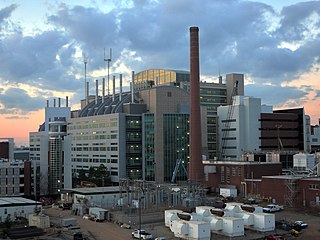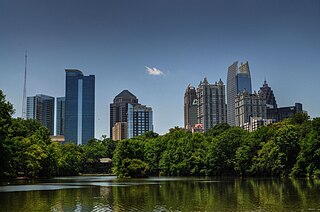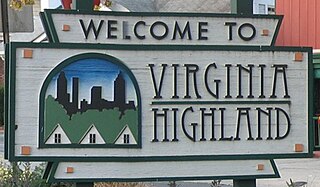
Druid Hills is a community which includes both a census-designated place (CDP) in unincorporated DeKalb County, Georgia, United States, as well as a neighborhood of the city of Atlanta. The CDP's population was 14,568 at the 2010 census. The CDP formerly contained the main campus of Emory University and the Centers for Disease Control and Prevention (CDC); however, they were annexed by Atlanta in 2018. The Atlanta-city section of Druid Hills is one of Atlanta's most affluent neighborhoods with a mean household income in excess of $238,500.

Midtown Atlanta, or Midtown for short, is a high-density commercial and residential neighborhood of Atlanta, Georgia. The exact geographical extent of the area is ill-defined due to differing definitions used by the city, residents, and local business groups. However, the commercial core of the area is anchored by a series of high-rise office buildings, condominiums, hotels, and high-end retail along Peachtree Street between North Avenue and 17th Street. Midtown, situated between Downtown to the south and Buckhead to the north, is the second-largest business district in Metro Atlanta. In 2011, Midtown had a resident population of 41,681 and a business population of 81,418.
Kirkwood is a nationally designated historic neighborhood on the east side of Atlanta, Georgia, United States. It is an historic streetcar suburb situated entirely in DeKalb County, bordered by the neighborhoods of Lake Claire, East Lake, Edgewood, and Oakhurst. Kirkwood is bound on the north by DeKalb Avenue, on the south by Memorial Drive and Interstate 20, on the west by Montgomery Street, and on the east by 1st Ave. A large part of the neighborhood is listed on the National Register of Historic Places as Kirkwood Historic District.

Virginia–Highland is a neighborhood of Atlanta, Georgia, founded in the early 20th century as a streetcar suburb. It is named after the intersection of Virginia Avenue and North Highland Avenue, the heart of its trendy retail district at the center of the neighborhood. The neighborhood is famous for its bungalows and other historic houses from the 1910s to the 1930s. It has become a destination for people across Atlanta with its eclectic mix of restaurants, bars, and shops as well as for the Summerfest festival, annual Tour of Homes and other events.

The Georgia Trust for Historic Preservation is the United States' largest statewide, nonprofit preservation organization with more than 8,000 members. Founded in 1973 by Mary Gregory Jewett and others, the Trust is committed to preserving and enhancing Georgia's communities and their diverse historic resources for the education and enjoyment of all.

The Medical Arts Building is a Beaux-Arts style building located at the northern end of Downtown Atlanta. The 12-story brick and limestone building by architect G. Lloyd Preacher, also designer of Atlanta City Hall, was constructed in 1927. In addition to its medical facilities - deemed as some of the most modern and well-equipped when it opened, the building once featured a cafeteria, drugstore and telegraph office. It was also amongst the first to have a covered parking garage. However, its nearly 89,000 square feet (8,300 m2) of space have been vacant since 1995.

The Rufus M. Rose House is a late Victorian, Queen Anne style house located in the SoNo district of Atlanta, Georgia. Occupying a narrow lot on Peachtree Street, one and a half blocks south of North Avenue, the house was built in 1901 for Dr. Rufus Mathewson Rose. The architect was Emil Charles Seiz (1873–1940), who designed many residential and commercial structures in the city, including the 1924 Massellton Apartments on Ponce de Leon Avenue.

English Avenue and Vine City are two adjacent and closely linked neighborhoods of Atlanta, Georgia. Together the neighborhoods make up neighborhood planning unit L. The two neighborhoods are frequently cited together in reference to shared problems and to shared redevelopment schemes and revitalization plans.

Haralson Bleckley was an American architect who designed many buildings in his hometown of Atlanta, Georgia. Several of his works are listed on the National Register of Historic Places (NRHP). His office was in the Flatiron Building. He also proposed the Bleckley Plaza Plan, a largescale architectural project that would have seen the creation of a large plaza in downtown Atlanta.

The Carnegie Building is a historic building located at 141 Carnegie Way in downtown Atlanta, Georgia, United States. Built in 1925 as the Wynne-Claughton Building, the 12-story building was designed by architect G. Lloyd Preacher. It was designated an Atlanta Historic Building in 1990 and was added to the National Register of Historic Places in 2012.

The B. Mifflin Hood Brick Company Building is a historic building in Atlanta, Georgia. Located in the Virginia–Highland neighborhood, the building was built in 1909 and was added to the National Register of Historic Places in 2018.

Founded in the 1830s as a railroad terminus, Atlanta experienced rapid growth in its early years to become a major economic center of Georgia, with several hotels built to accommodate for this growth. Following its destruction during the Civil War, Atlanta experienced a resurgence and another hotel boom commenced in the late 1800s through the early 1900s. In the later half of the 20th century, hotel skyscrapers began to appear on the skyline, including what was at the time the tallest hotel in the United States. Later, a trend emerged of converting old office buildings into boutique hotels.

The Glenn Building is a historic building on Marietta Street in downtown Atlanta, Georgia, United States. Built in 1923 as an office building, the building was converted to a boutique hotel in 2006 and added to the National Register of Historic Places in 2008.
Kathryn Johnston Memorial Park is a park in the English Avenue neighborhood of Atlanta, Georgia, United States.

All Saints' Episcopal Church is an Episcopal church in Atlanta, Georgia. The church was founded in 1903, with the current building constructed in 1906.
Lindsay Street Park is a public park in the English Avenue neighborhood of Atlanta, Georgia. Opened in 2015, it is the first park to be opened in English Avenue

The Kodak Building is a historic building in Atlanta, Georgia. Built in midtown Atlanta around 1950, the building originally served as a camera shop, with a large sign on top of the building advertising Kodak considered a local landmark. The building has been vacant for several years, but was recently sold and is scheduled for redevelopment.

The Whitehall Street Retail Historic District is a historic district in Atlanta, Georgia, United States. The district is centered on Peachtree Street and Martin Luther King Jr. Drive and includes Broad, Forsyth, and Mitchell Streets. It was added to the National Register of Historic Places in 2020.
The M.C. Kiser Company Building is a historic building in Atlanta, Georgia, United States. Located in the South Downtown neighborhood, it was built in 1923 as a shoe factory, converted to apartments in 2017, and added to the National Register of Historic Places in 2019.
Glenridge Hall was a historic property in Sandy Springs, Georgia, United States. The house was built in 1929 and listed on the National Register of Historic Places in 1982. The site was demolished and delisted in 2015.


















